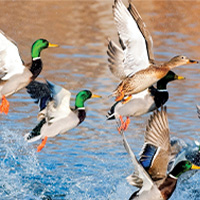SUNY ESF
ESF Leads Study of Dwindling Eastern Mallards
 As the U.S. population of eastern mallards has plunged inexplicably by 50 percent
in the last 20 years, an ESF scientist and several partners are working to solve the
mystery with a research effort called Rescue the Eastern Mallard.
As the U.S. population of eastern mallards has plunged inexplicably by 50 percent
in the last 20 years, an ESF scientist and several partners are working to solve the
mystery with a research effort called Rescue the Eastern Mallard.
Michael Schummer PhD '98, a faculty member in the ESF Department of Environmental Biology, said the mallards' plight highlights an urgent need for humans to address biodiversity loss and devise ways to accommodate wildlife in developed areas.
"If we don't figure this one out, we're in trouble," he said. "We have imperiled species in faraway places that are much more isolated. Here, we have an opportunity to answer some important questions about what happens when even common species start to decline. We are working in one of the most populated places on Earth, and we have access to lots of birds and data. If we can't find a way to keep animals with us in this urban environment, where is it going to happen?"
The scientists are using innovative techniques to analyze elements locked in mallard feathers to understand where eastern mallards are hatched. High-resolution satellite imagery helps researchers understand how changing landscapes influence the number of mallard ducklings produced. And new genetic technologies and techniques enable them to determine the genetic diversity of mallards regionally.
The Schummer Lab for Waterfowl and Wetlands Conservation at ESF is partnering on the project with Delta Waterfowl, Ducks Unlimited and Birds Canada. ESF ran a grassroots fundraising effort in 2019 to support the research; donors responded generously, contributing $50,000 to help get the project started. Altogether, private donors have contributed more than $150,000 to support the mallard project.
Schummer's lab is also the conduit for a $900,000 National Science Foundation grant that is being applied to collaborative research with other institutions, including the University of Texas El Paso, Forbes Biological Station, Mississippi State University, the Smithsonian Institution and Western University.
"This emphasizes the invaluable role of philanthropic funding," said Dana Piwinski, senior director of major gifts in the ESF Office of Development. "Funding from donors enables Dr. Schummer to secure those larger federal grants by supporting initial and proof-of-concept research with students. The gifts that come to ESF from private donors in support of this project provide a framework that leads to substantial support from funding agencies such as the NSF." Philanthropic funding partners include Waterfowl Research Foundation, The Robins Island Foundation, the Camp Fire Conservation Fund and The Long Island Wildfowl Heritage Group.
